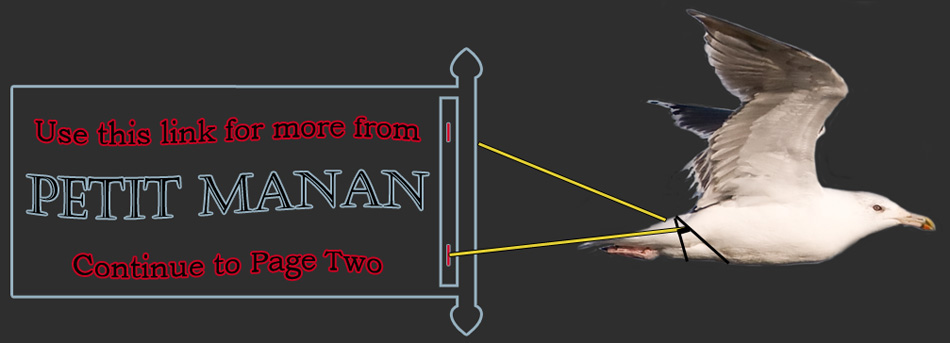
|
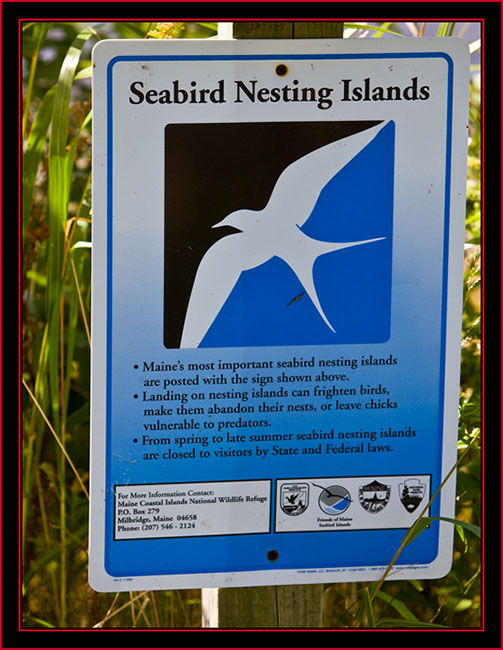
|
I spent four days at Moosehorn National Wildlife Refuge in two separate visits in August before this account took place. This field time will be the subject of next photojournal I’ll document. Meeting Andy Weik in the Baring Division of Moosehorn NW Refuge was truly a
pleasure and we spent time together when I first arrived to aid my becoming orientated a bit. There are two divisions of this Maine refuge, Baring and Edmunds, named for the towns in which they are located. When I got home and expended the many hours required
evaluating/enhancing the image group from my field time I sent the photographs on a flash drive along with a group of prints to Andy’s office. The staff was appreciative of this effort and Andy indicated he/they were duly impressed by the quality of the work, the prints in particular
were excellent and well received. Everything about this was a win-win and I thoroughly enjoyed my time in Moosehorn NW Refuge. We corresponded, planned to stay in touch and I asked him to keep me informed if anything out of the ordinary was planned at the refuge as I’d come
north with my cameras…
It was the evening of Labor Day, September 7th, and I’d been in my digital lab doing what I’m always doing when I find time – evaluating and printing photographs. When I went upstairs Linda indicated somebody had called my mobile so I went over to check it out. I was surprised to learn Andy had called. This was nice of him I thought; it was a holiday and certainly he had family things going on. His message was poignant and got my attention. An Eider Duck round-up and banding session was planned for Petit Manan Island and he’d arranged for me to go along if I could make it. However, in order to do this I had to go the next day, a Tuesday, and stay until Thursday to keep in synch with the boat schedule. As I listened to this information I clearly understood what an opportunity this was. My first inclination was I can’t go on such short notice. I should clear the absence through my office beforehand, mostly as a courtesy actually, and do the things we all do when anticipating time away. The short time I dwelled on this after hearing Andy’s message and further considered the issues led me to conclude I simply had to make the trip. I’d promoted this rapport with the refuges and didn’t wish to refuse the very first time I was asked. I returned Andy's call, received the information on who, what, when & where, thanked him profusely and started organizing my camera equipment… |
About the Eider Round-up and Data Collection…
|
I learned more about why these duck ‘round-ups’ are necessary (more on why this is referenced as such later) and the value of the information then I ever thought possible… Andy Weik had provided contact information for two
individuals before I left on the trip, Linda Welch at the United States Fish & Wildlife Service (USFWS) offices in Milbridge and Kelsey Sullivan, a wildlife biologist who works with migratory and upland game birds with the Maine Department of Inland Fisheries and Wildlife
(MDIFW) out of their Bangor offices. Kelsey was a proverbial font of information and like all involved with the project, passionate about this effort. The Eider round-up is a result of a cooperative effort under the joint
auspices of the USFWS Petit Manan, Maine Fish and Wildlife and the United States Geological Survey
(USGS), Orono, Maine Field Station, that commenced in 2002. Maine Fish and Wildlife is using the banding information as a tool for management and conservation of Common Eiders in a program acquiring data through 2016. MDIFW
and USGS are the lead investigators in the larger scale eider survival and harvest rate study that is underway concurrently. The co-investigators for the eider project are Brad Allen, MDIFW and Dan McCauley, USGS along with USFWS. All these agencies were represented at the round-up. It was informative, interesting – I would comment personally, actually amazing - and demonstrated an outstanding achievement of inter-service cooperation that was most impressive to a layman like me.
Probably everyone is aware to some degree that overall populations of birds in general are declining… There are species of sea ducks noted as radically in decline across North America including populations of all four eider species – Common Eiders, the subject of this data collection, King Eiders, Spectacled Eiders and Steller’s Eiders. These species may have declined as much as seventy-five to ninety-five percent – truly catastrophic numbers by any measure. Kelsey talked with me about eider hunting in our state as well. Eiders are the most hunted sea duck in Maine, which constitutes eighty percent of Maine's sea duck harvest. They also encompass over twenty percent of the Atlantic Flyway sea duck harvest. Maine has an estimated 2,300 plus sea duck hunters… Kelsey informed me there are guides in Maine who make the bulk of their livelihood from the sea duck hunting season, a fact I was clearly unaware of before our discussion. Kelsey Sullivan, MDIFW, with a Handful of Common EidersCanon EOS Mark III 1Ds on tripod, 1/1600 second at 840mm; EF600mm f/4L + 1.4X at f/8, ISO 640 |
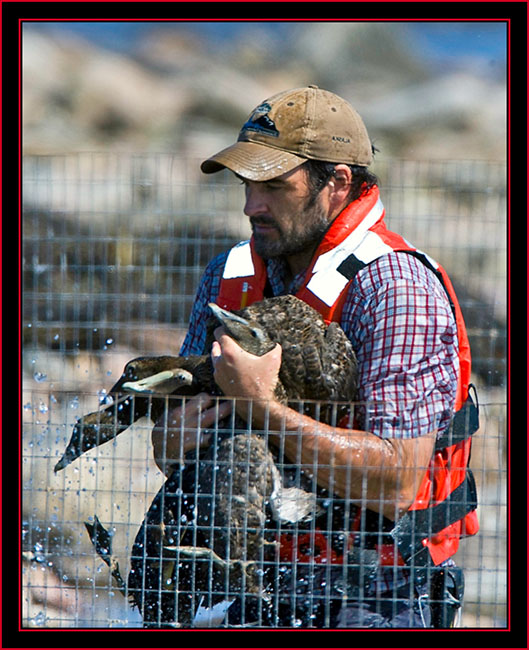
|
Common Eider
Canon EOS Mark III 1Ds on tripod, 1/1000 second at 840mm; EF600mm f/4L + 1.4X at f/8, ISO 640 with Flash
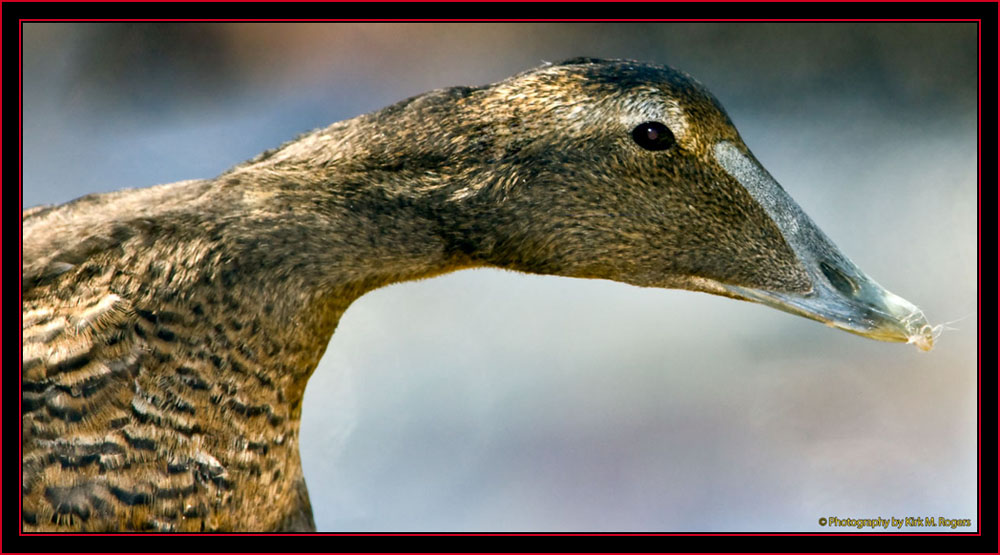
|

|
There is one other item I learned about that I’ll mention here – hopefully never to be an issue again... I’d never met Linda Welch but she and Andy had worked together over the years and although now in separate refuges they remained colleagues and friends. I didn’t know this at the time but apparently it was this mutual respect alone that got me on the boat as Linda was a bit incredulous about my participation. Not me as an individual per se – we hadn’t met yet – but because I was a photographer. After we did meet and I had an opportunity to talk with Linda, like Andy truly an exceptional individual, I learned she’s had some poor experiences in past times. Linda wasn’t specific about when or where but did mention one example where she went out of her way to aid a couple photographing together. These folks took countless images and in the end result, Linda never received even one for her refuge archive after the fact. This and similiar events had jaded her to a degree and she was upfront & direct with me when relating this account. I wasn’t alarmed because I knew she’d be pleased with what I produced and further, I knew there was absolutely no question that whatever I came back with she’d receive in the enhanced file versions with a high resolution print group besides… All I could say was as a registered volunteer I’d do the same thing in her refuge as in the others I’ve worked in – I take this effort seriously and I always follow up. Why anybody would not do the same is beyond me – being able to spend time in these refuges is a privilege. My goal is to produce excellent photographs because I enjoy it and wish to make a contribution in the process. After I’d returned and was working with the files Andy emailed and said not to worry – Linda would be a believer soon enough… Predicated upon the comments when I did forward the image files and prints, I believe this may well be the case. In any event, I thank Andy and Linda heartily for making this trip possible. I cannot speak for them, but they sure managed to make a believer out of me - it was a wonderful experience… |

|
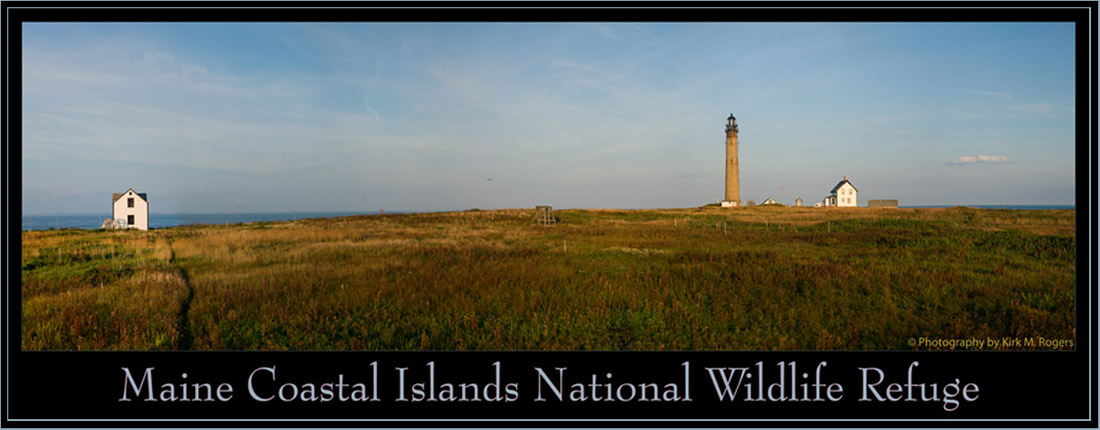
|

|
I made the drive to Milbridge, nearly four hours from my home location, found the refuge offices and went in to introduce myself. The boat was heading out in the early afternoon and I made certain to arrive with plenty of time to spare to organize my camera equipment, learn the transport process and to gather up some groceries prior to departure. Linda may have had reservations about photographers but she was nothing but kind to me once we met. She indicated exactly what I needed to do and we traveled to the store together as she was purchasing supplies for staff residing on the island. Upon our return she escorted me to the rear of the building and directed that I find boots and a flotation jacket off the rack for the outward trip. She also helped me locate dry bags for everything I was transporting – an article they had plenty of I saw. I learned that everything gets placed in dry bags… They don’t take chances on anything receiving water damage through spray or immersion. I was concerned about transporting my 600 millimeter lens in the case it came in – the first time I think I’ve ever used this – but I was able to find a dry bag that it fit in perfectly. I hung around near the overhead doors at the rear of the facility while the crews loaded everything in preparation for the drive to pier. |
When it appeared we’d be leaving I completed the final equipment check and packed all the camera gear into dry bags except for the Canon EOS 1Ds Mark III body with a 400mm f/5.6L lens. I carried this on a shoulder
strap just in case anything opportunistic occurred while at sea and could still keep my hands free. I’d put a lot of thought into what to bring to the island
and scaled down my equipment and clothing just in case. I didn’t know anything about how the process worked and how much I could or would be allowed to transport so was conservative
in planning. I was a guest on this trip - a supernumerary - and after learning of Linda’s concerns I made a point to stay quiet & observe, help when I could or was asked and most
importantly – to stay out of the way. I’m far from shy or introverted but I didn’t know a soul among this group and wasn’t certain how I may be received by the state and federal
employees who would be attending the banding session.
Linda's Dog Boo... |
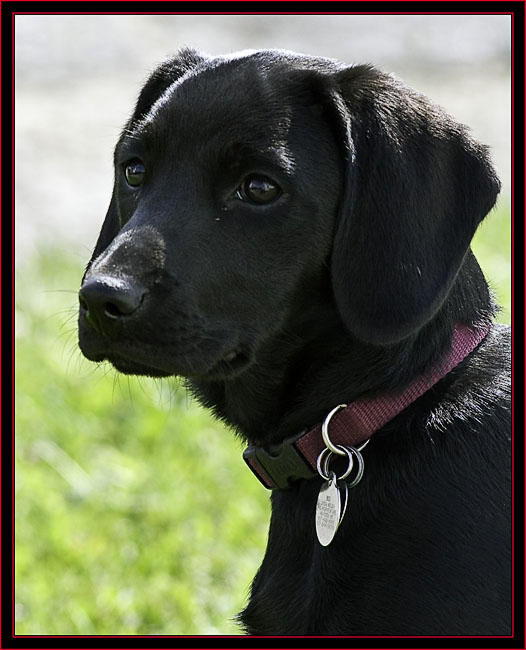
|
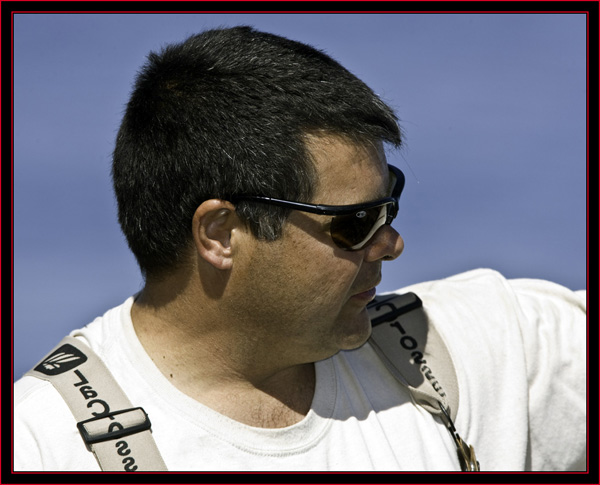
|
The outward leg was uneventful and took about half and hour or so. The boat was freighted up forward with dry bags, including three of mine and some kayaks for the round-up. I think there were seven or eight of
us aboard. I learned a second vessel would be coming out later in the day with the balance of the round-up/banding crew. I was in the stern by the captain who introduced himself as Jim Fortier. Jim asked
me a few questions – do I have any health conditions he should be aware of, can I swim - things of that nature. I told him I was healthy, had no plans to become ill or incapacitated baring a mishap
and yes on swimming. I’m a certified diver with over five hundred underwater hours logged although none in recent history. I talked with Jim quite a bit over the next days and learned through observation
and our discussions that among other
things he is an expert small craft operator and serves as the facility maintenance chief. He was all over the various tasks related to getting the buildings ready & the island facilities buttoned up for cold
weather with his associates.
Once in open water there was little possibility of obtaining any type of exposure from the boat as it scudded along at full throttle... I took my hat off to keep from losing it, adjusted the camera away from the gunnels out of the spray and enjoyed the ride. Jim on the Island...Canon EOS Mark III 1Ds on tripod, 1/1000 second at 840mm; EF600mm f/4L + 1.4X at f/8, ISO 640 |
Approaching Petit Manan
Canon EOS Mark III 1Ds, 1/1000 second at 70mm; EF70~200mm f/2.8L at f/11, ISO 320
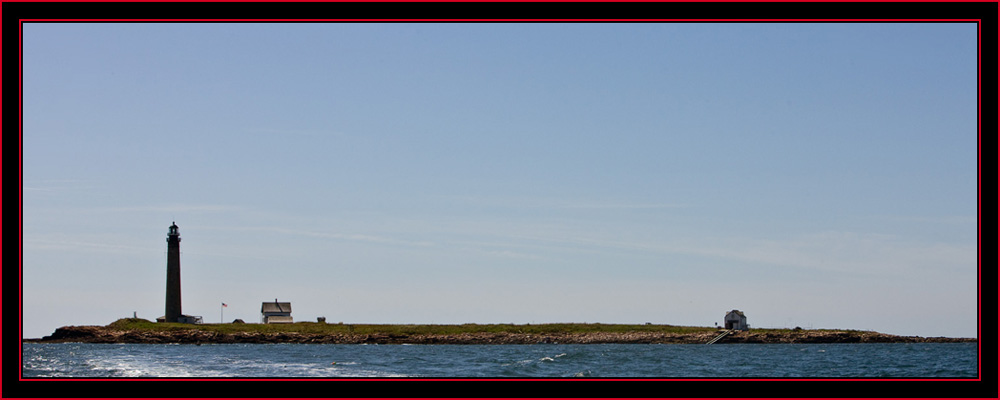
|
Petit Manan Island is small hunk of rock in the Gulf of Maine and is part of the Town of Stueben in Washington County. Acquired by the USFWS from the U.S. Coast Guard in 1974 it is considered an important seabird nesting site. It lies approximately three miles south of Petit Manan Point and there is a treacherous bar running between the island and the point on the mainland. Recognizing the need for aids to navigation in this fogbound area, President James Monroe authorized the building of a lighthouse on Petit Manan Island in 1817. Adjacent to Petit Manan is Green Island and the two are connected by a cobble bar. At low tide one can walk between them for a visit and I obtained some images of Kelsey doing just that. Green Island is under the auspices of MDIFW and in recent years this agency and USFWS have managed the islands as a single unit.
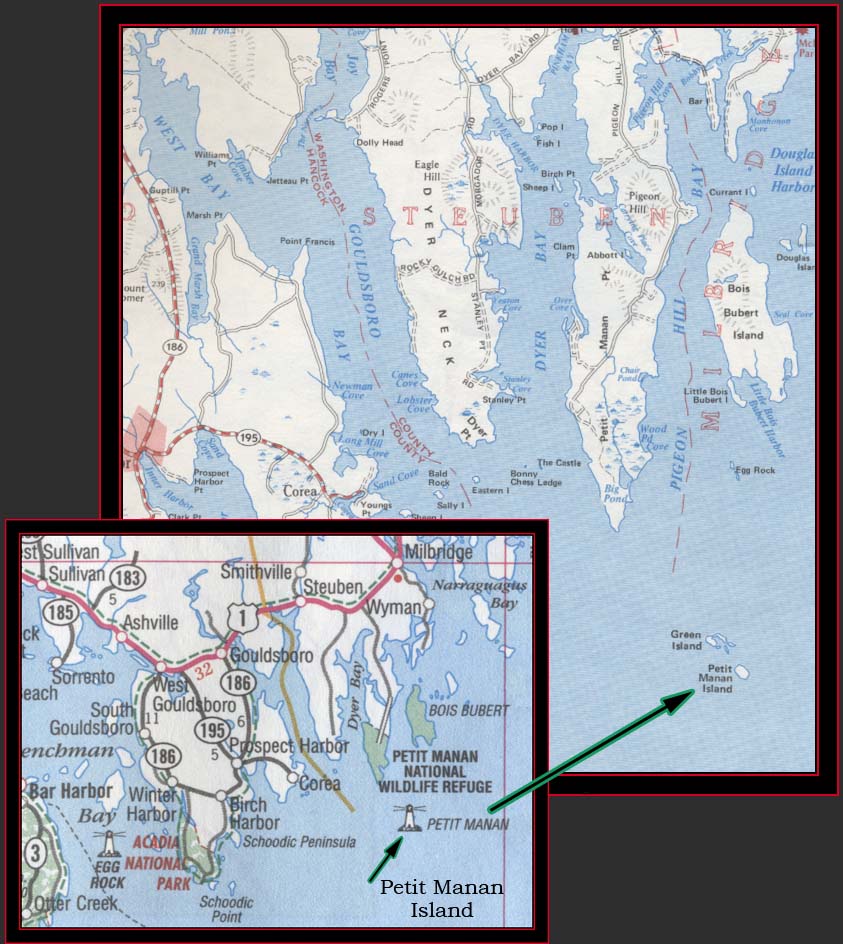
|
Before we left when talking with Linda I learned that due to other commitments she wouldn’t be able to attend the round-up. She also indicated the state of the tide would determine how the arrival on the
island would be accomplished. Sometimes at higher water the boat can be be brought close enough to the ramp to walk off, other times like at low tide everything had to be shuttled via smaller craft. Our arrival today wasn’t
too difficult and Jim was able to maneuver the boat onto the ramp so the gear could be passed forward. Everyone walked off the bow and onto the parallel wood beams of the boat ramp or the slats between
them. It wasn’t difficult to see why hip boots were the order of the day – everybody was wearing boots – I don’t think you could get up the ramp without at minimum having wet feet. It didn’t take long for
the unloading process to complete and the gear was moved up the ramp into or around the area of the boathouse. When you think about it, everything here had to be transported to the island with this process,
people, provisions, equipment – everything, afterwards the process reversed and everything not staying was taken off and returned to the mainland. Obviously enough, planning is an important aspect when
conducting any type of operations on the island. I learned that whoever arrived on the island today was staying overnight. Some would return the next day but most were here for the eider round-up and
would complete the pre-round-up preparations and be available for the event.
The Arrival... |

|

|
I located my bags and of course, wished to break out my camera gear first thing. Before doing this however, I figured it would be best to find out about accommodations so I could unpack hopefully without re-packing to move again. I don’t know for certain but suspected I was the only individual in the group who was here for the first time. That plus as indicated, I was a supernumerary, left me at a disadvantage as to how to proceed. Some guys called out spaces in the boathouse, which had beds in the upper level, perhaps sleeping three or four. Wanting to get my gear out of the way, I asked about this and took my bags upstairs. The only other accommodations were in the former light keeper’s house up the hill. I figured I'd stay in the boathouse and out of the way; in the end result this worked out splendidly. One of the USFWS staff, Steve Agius, probably sensing my uncertainty, came over to speak with me. We went upstairs where he pointed out a bed and indicated I should unpack in this area. I believe Steve had already claimed the spot and was kind enough to accommodate me which was much appreciated.
Brian Allen & Brian Pauly Prepping the Boathouse for New PaintCanon EOS 5d, 1/500 second at 400mm; EF400mm f/5.6L at f/8, ISO 400 - taken from the lighthouse |
View from the Landing
Canon EOS Mark III 1Ds, 1/500 second at 50mm; EF24~105mm f/4L at f/8, ISO 1000
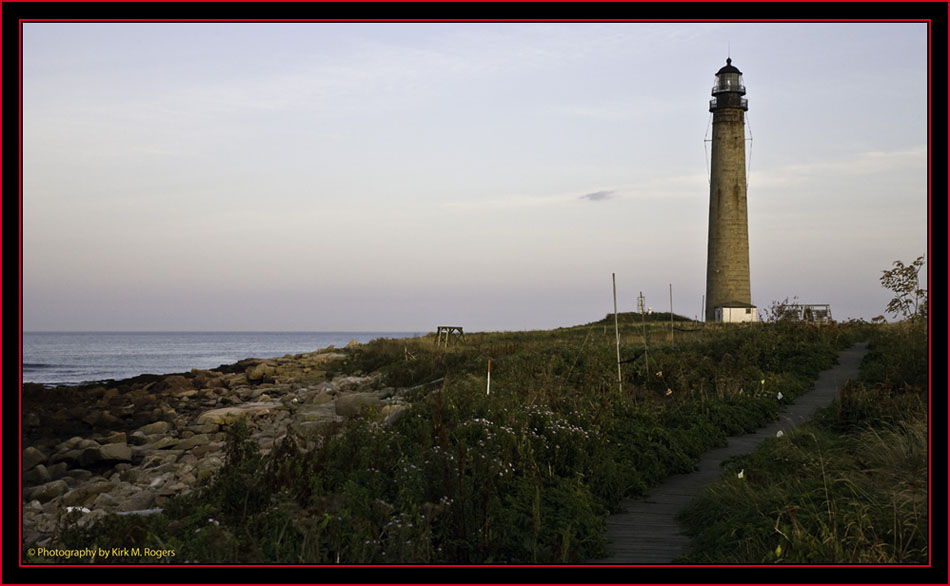
|
Lighthouse & Buildings, Petit Manan Island
Canon EOS 5d, 1/320 second at 75mm; EF24~105mm f/4L at f/11, ISO 400

|
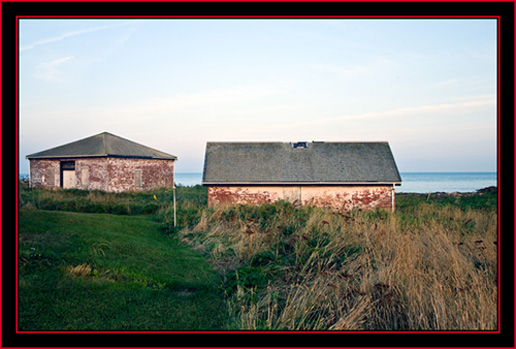

|
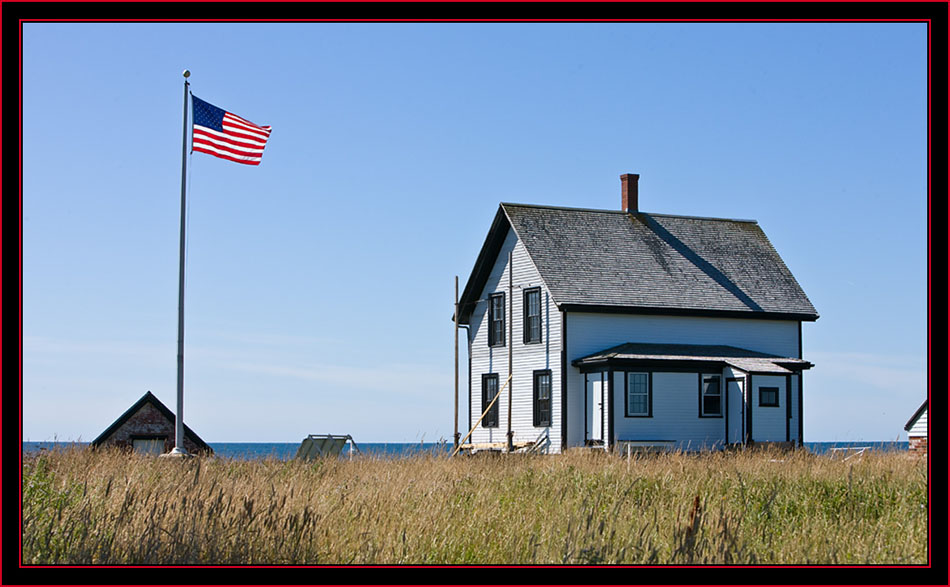
|

|
Steve had some time available and showed me around the island. We went into the house,
the primary residence and after-hours gathering place on the island, so I could look around and refrigerate what I’d carried along for food. I spent little time in the house during my time on Petit Manan, a bit in the
kitchen area and even shorter time in the living room as we sat around and talked. The house is solar powered with a battery storage system that I was informed worked well although there were times when the batteries could
be discharged enough to be problematic. I learned there’s ample power to keep the lights on in the evenings, run the refrigerators, etc. Steve asked if I wanted to get up into the lighthouse and soon we were climbing the
spiral staircase. The light is noted as being 123 feet above mean high water, the second tallest on the Maine coast, but by the time we got to the stairwell exit I would have thought it was five times that height… While
we were topside the second boat from Milbridge was viewed making an approach. I was in a perfect location to photograph the arrival. Steve left to go about his duties while I sorted my camera equipment and did what I
came here to do – take photographs. As I walked the grounds my photographer’s eye saw countless possibilities – I knew it was going to be a great few days in a Maine paradise.
Steve Agius in Portrait...Canon EOS 5d, 1/2000 second at 400mm; EF400mm f/5.6L at f/5.6, ISO 640 |

|
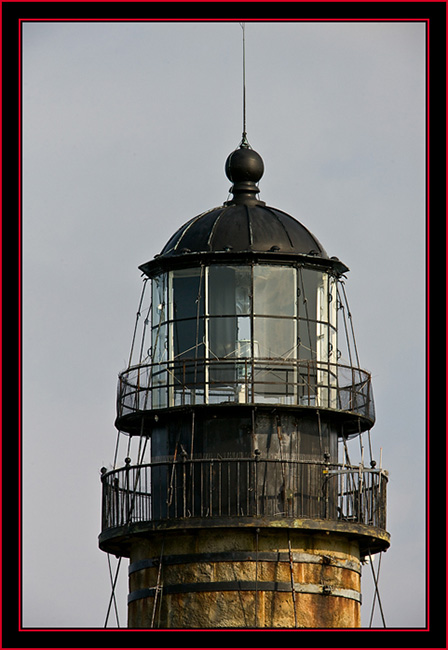
|
I’d mentioned previously that the lighthouse is the dominant landmark on the island. As a matter of fact it often appears when people refer to Petit Manan as a location they’re referring more or less to the
lighthouse. This does not include seabird advocates, career biologists, students and others working in support of the refuge of course; their view differs significantly. There is a plethora of information of historical
import available about the lighthouse on Petit Manan Island so I won’t go into great detail in this account. However, there are a few pertinent facts I will address here… The station was established under Monroe’s
Presidency in 1817 and the first tower constructed. An 1851 inspection of the facility indicated the stone lighthouse structure initially constructed would have to be replaced. The present 119-foot granite tower was constructed in 1855. The
granite was cut, the tower built and then disassembled, the stones labeled, transported to the island and re-assembled. The lighthouse suffered storm damage over the years, 1869 being noted as particularly malevolent
with a storm so severe the tower deflected violently, damaging the clockwork weights that turned the lens. Some of the stones were displaced and fell destroying several of the spiral staircase treads. In 1887 iron tie rods were
installed to strengthen the tower allowing the structure to weather many more years of Maine's coastal environment. These tie rods can be viewed today. The original lens was a second order Fresnel (pronounced 'fray-nell' after French physicist Augustine-Jean Fresnel, who designed the parabolic lens type) of a beehive design that was 6’ – 1” in height and 4’ – 7” in diameter. Lighthouse lenses are
ranked in six sizes entitled orders – the weakest, ranked sixth and used in inland waterways to the first-order - the brightest and deemed suitable for fog-bound coasts. The US Coast Guard automated the light in 1972
and a new lighting device was installed. At the time of the automation this was a DCB-224 Aerobeacon, the light that replaced the Fresnel in U.S. lighthouses in the late 1950's, and was designed for use in aiport applications.
Nowadays a VRB-25 Aerobeacon is employed and emits a white flash every ten-seconds.
The tower appears to be in reasonable condition as I viewed it but nobody was allowed access to the upper level walkway as can be seen in the image at left. I was okay with this to say the
least - I was high enough on the lower level… Petit Manan Light was listed on the National Register of Historic Places as Petit Manan Light Station on October 30, 1987.
When the light was automated Petit Manan Island was turned over to USFWS and became part of the 3,335-acre Petit Manan National Wildlife Refuge along with portions of Bois Bubert and Nash Islands. The lighthouse and foghorn equipment remained under the auspices of the U.S. Coast Guard.
As mentioned previously the name was later changed to the Maine Coastal Islands National Wildlife Refuge because this refuge encompasses 49 offshore islands and three coastal parcels, totaling more than 8,100 acres – a far greater outreach then just the areas at or around Petit Manan Island. This is an impressive refuge spanning more than 150 miles of the Maine coast and well worth the time to investigate.
Top of the Lighthouse TowerCanon EOS Mark III 1Ds, 1/2500 second at 840mm; EF600mm f/4L + 1.4X at f/8, ISO 640 |
Lighthouse Views - Petit Manan Island
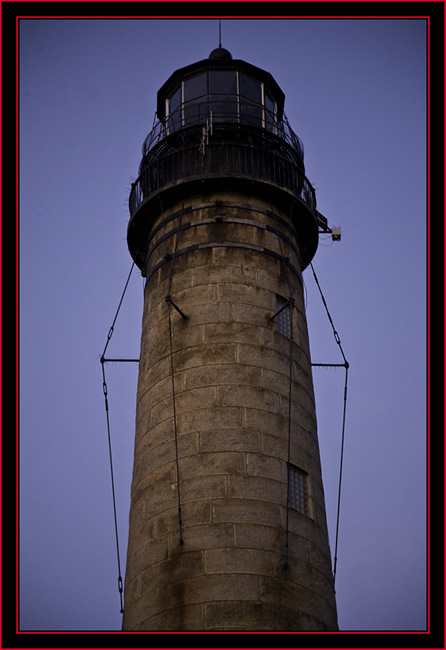
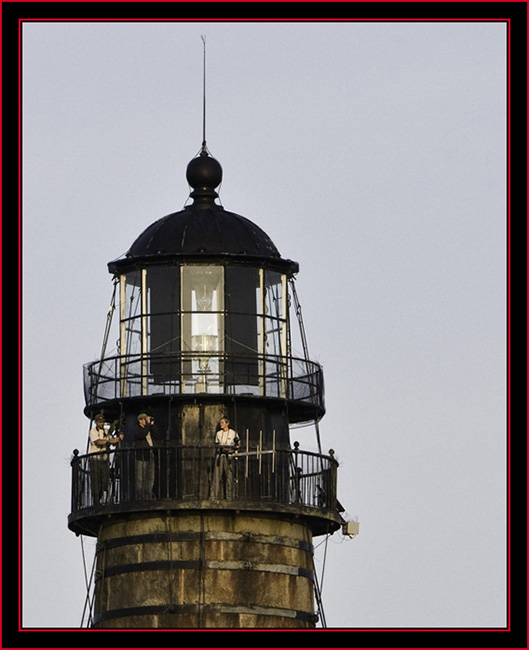
|
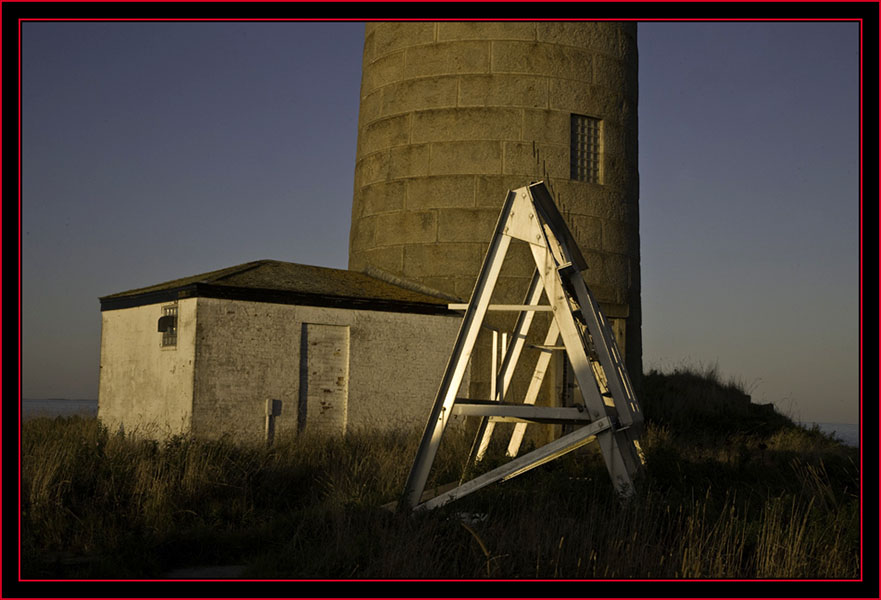
|
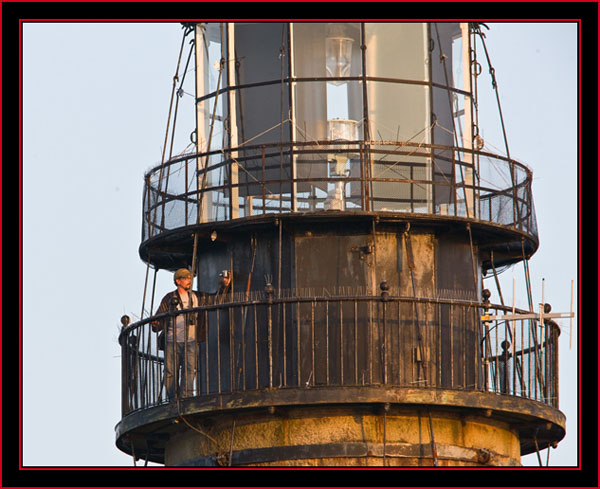
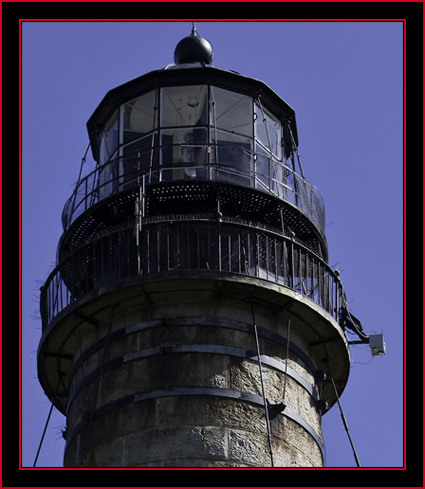
|
The balance of the round-up crew arrived on the second boat including Patrick Corr of USGS. Along with personnel the boat transported the materials required to construct a fence & impound employed to channel the eiders into a capture zone for banding. He later told me this technique was used in Canada and the method was investigated for use in Maine. They were taking a page from the Canadian playbook and modified for use at Petit Manan. There was much to do in preparation and little time was lost at low tide checking the capture zone and making plans. You may recall earlier when I’d stated that all the various crews were busy around the island… The next group of shots summarizes the late afternoon of the first day. Between preparations for the round-up and pre-paint activities on the buildings everyone was active.
Arrival and Unloading...Canon EOS 5d, 1/500 second at 400mm; EF400mm f/5.6L at f/8, ISO 400 - taken from the lighthouse |

|
Eider Round-up Preparations - Petit Manan Island

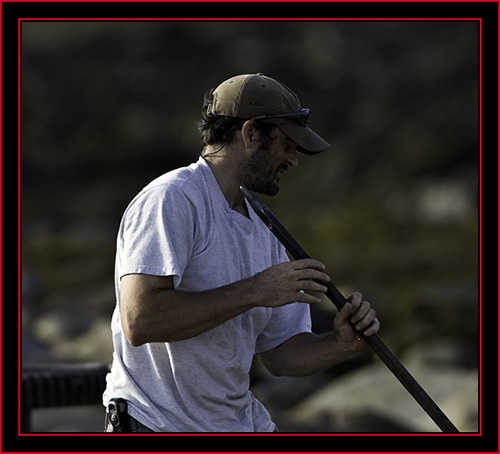
|

|
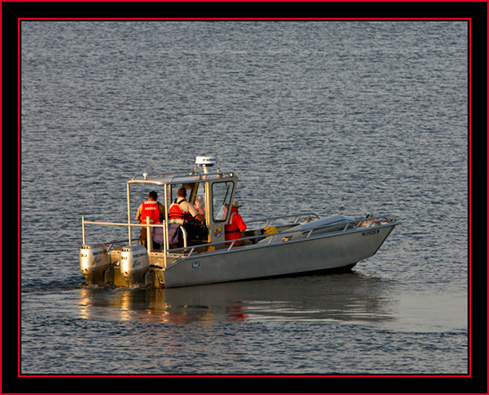

|
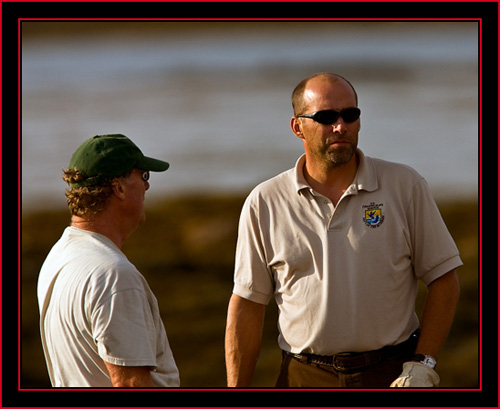
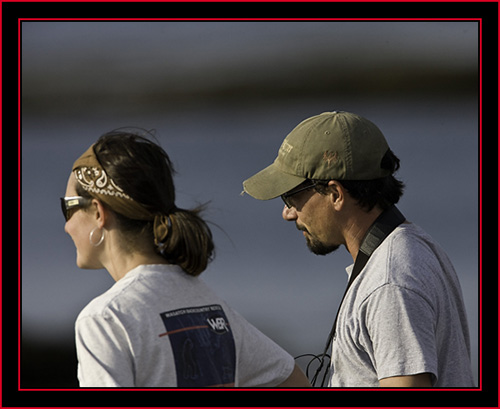
|
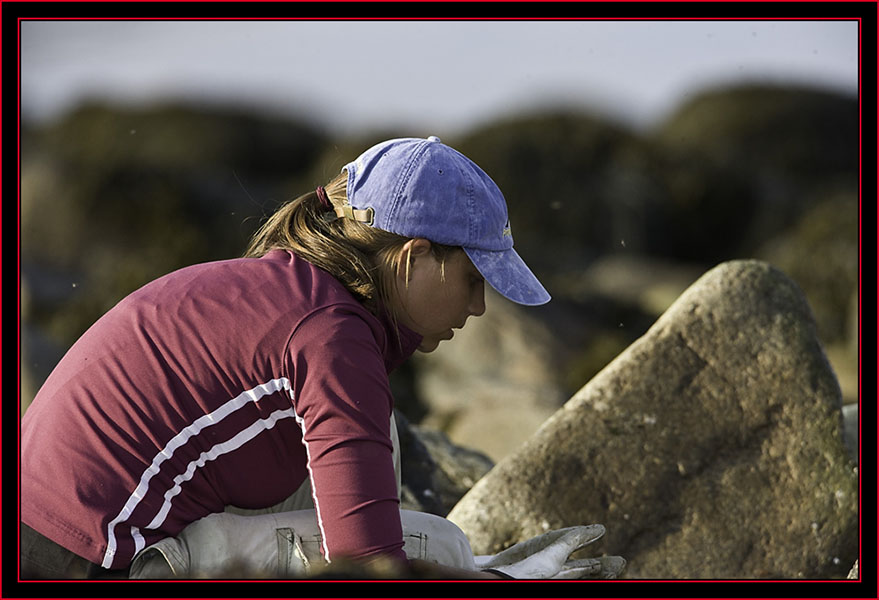
|
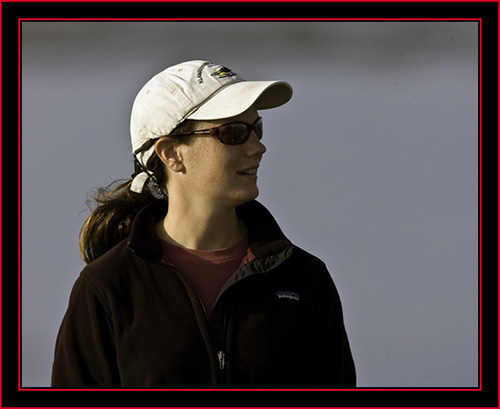
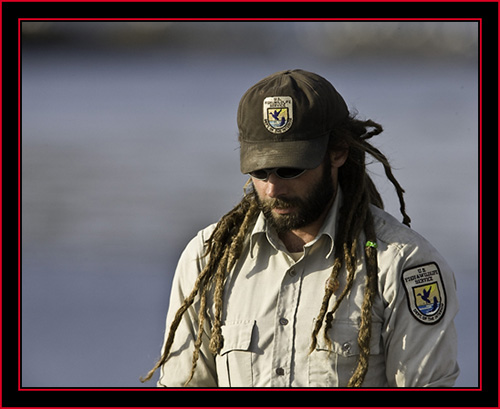
|
And Painting the Boathouse...
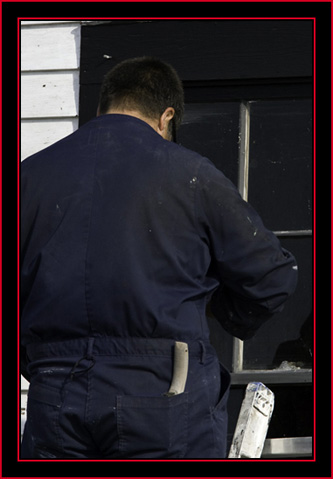
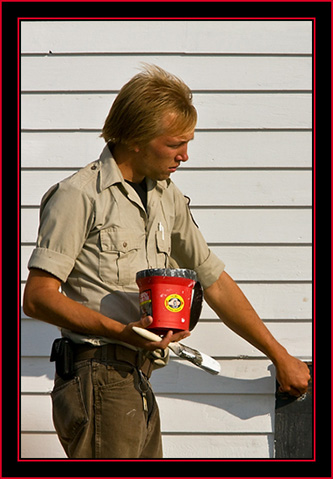
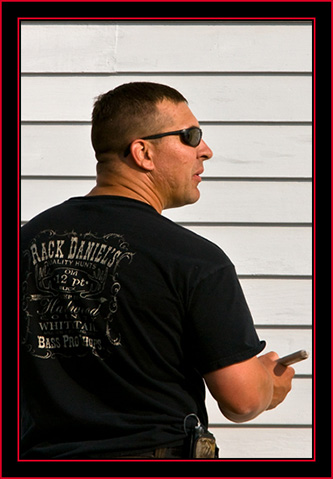
|
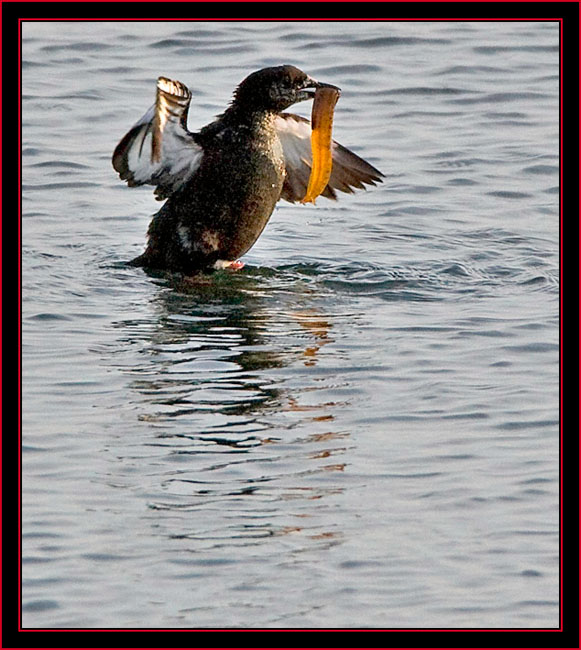
|
Having no particular assignment and left to my own devices I wandered about and observed the activities. The various agencies had gathered quite a talented group of individuals for the round-up and it was shaping
up to be a stellar event. A Black Guillemot was observed in the area and I asked if this was a typical sighting. I was Informed although late in the year, the bird was tending a nest not far from the boathouse. I was hoping to have an opportunity to photograph the guillemot at fairly close
range, but what I was told was true – the bird wouldn’t come onto the island as long as anyone was near to avoid pointing out the nest location. I’d observed many examples of this
bird previously but never obtained a photograph that I would consider better than average – mostly confirmation shots. It appeared it was now or never because things were going to get crazy with
activity so I took a few exposures for record, one of these can be viewed at left.
Black Guillemot with Red Rock EelCanon EOS Mark III 1Ds, 1/2000 second at 840mm; EF600mm f/4L + 1.4X at f/8, ISO 640 |
A Potpourri of First Day Shots…


|
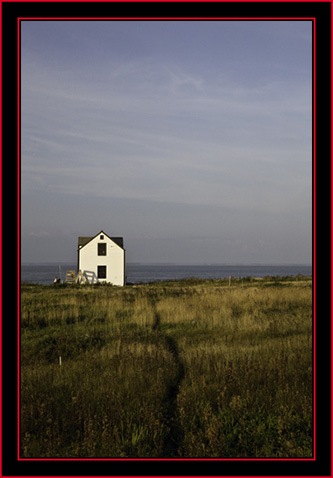

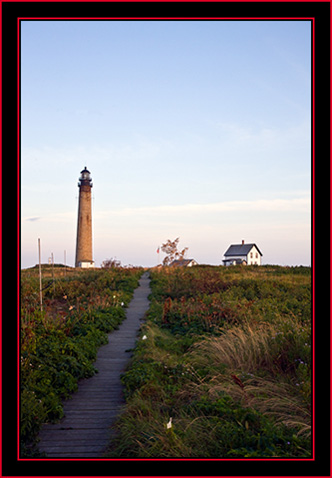
|

|


|
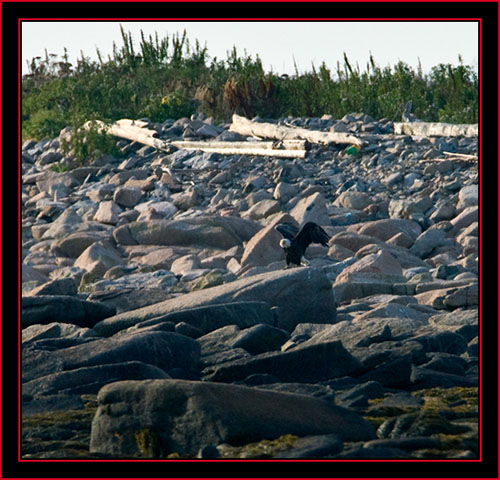
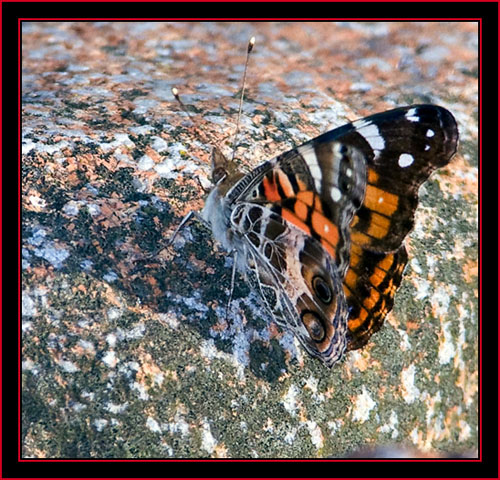
|
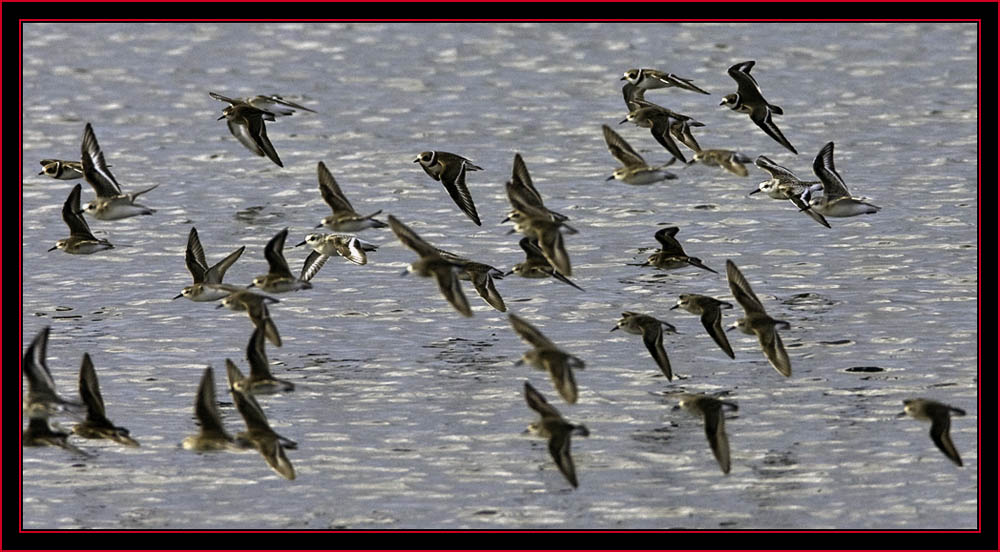
|
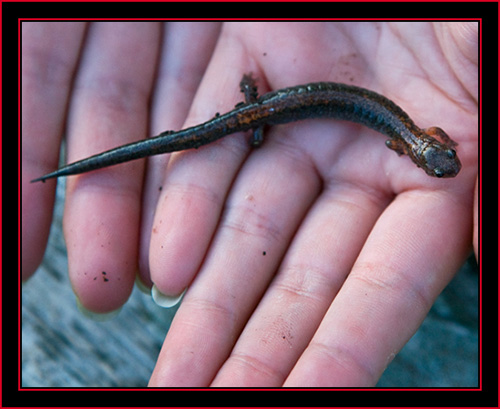
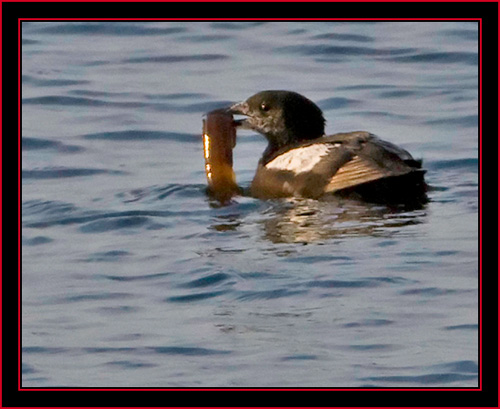
|
|
Pat had planned dinner this evening and soon everyone headed towards the house to enjoy the fruits of his cookout efforts. Things are kept simple as much as possible and everyone appeared to find things enjoyable after moving rocks and painting most of the afternoon. The photograph at right displays the failing light. Shot handheld, even at 3200 ISO, the shutter speed was too slow to stop movement. However, it was Pat’s birthday and as this was the only image I had of his celebration I’m adding it here… I was still trying to keep out of the way as much as possible and was preparing to photograph the sunset not far from the picnic table area looking towards Acadia National Park. When I got ready to do this I realized that when I scaled back on camera gear I didn’t bring either of my electronic cable releases to the island. This wasn’t an unmitigated disaster by any means but it would have proven helpful to control exposure lengths as I continued shooting into the evening.
Below is the some of the crew feasting on island fare... You can see Pat at left of the image making do with some creative seating… Pat with his Birthday Cake - 29 Again...Canon EOS Mark III 1Ds, 1/10th second at 85mm; EF24~105mm f/4L at f/4, ISO 3200 |
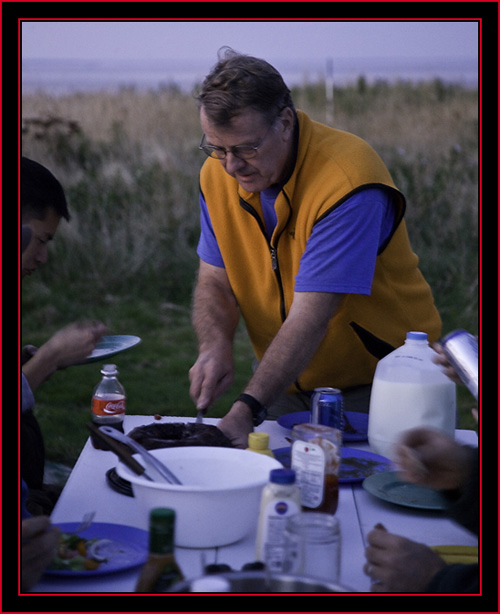
|
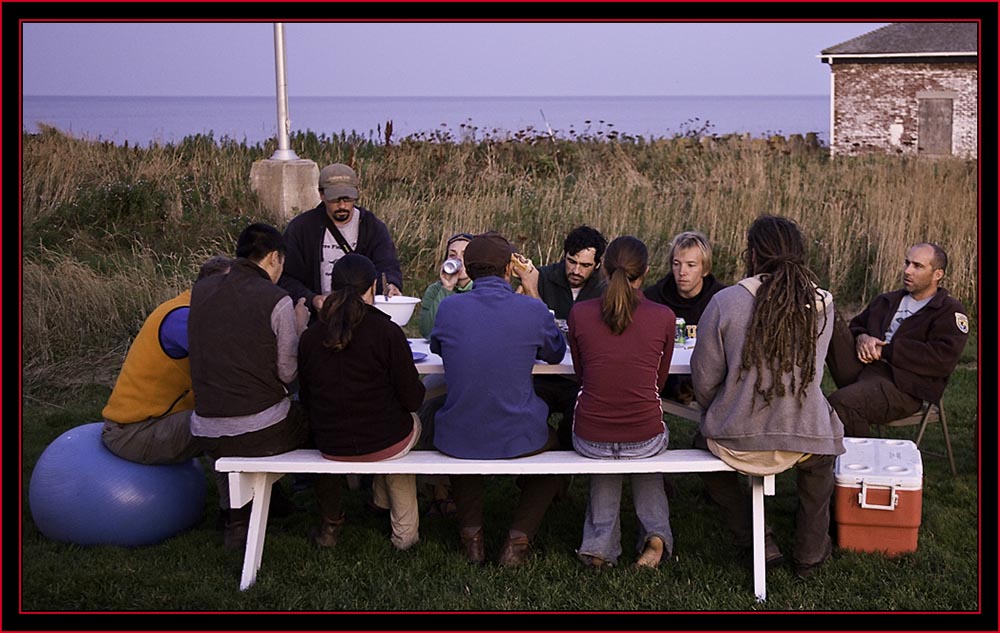
|
From Sunset into Astronomical Twilight...
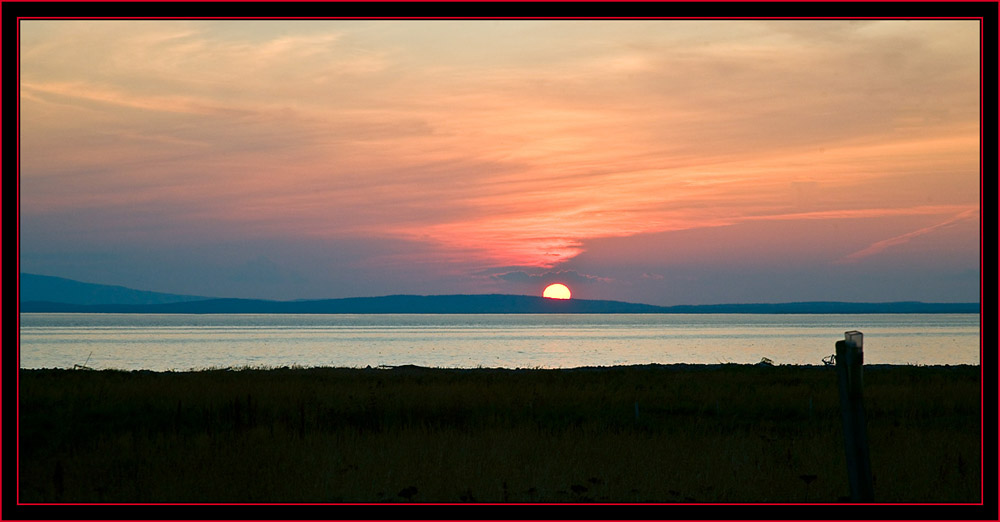
|
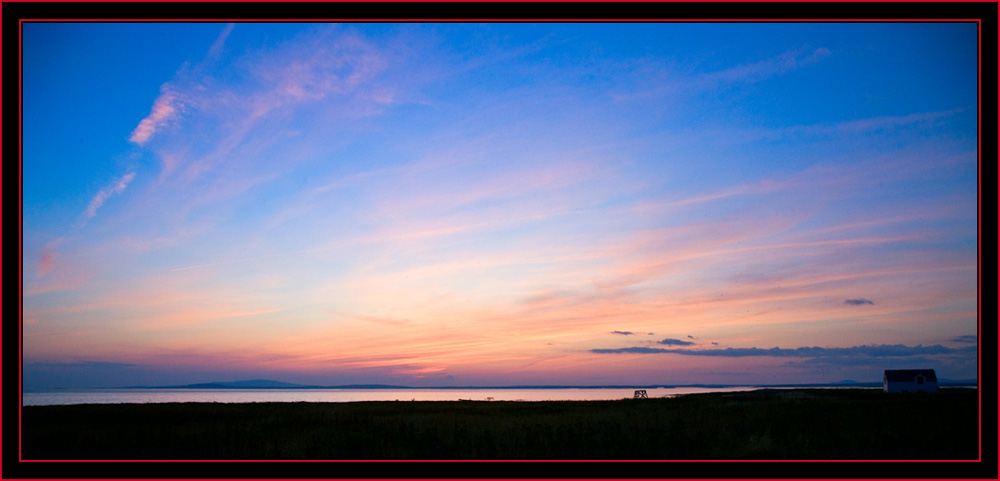
|
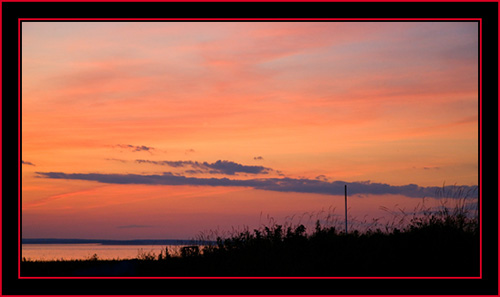
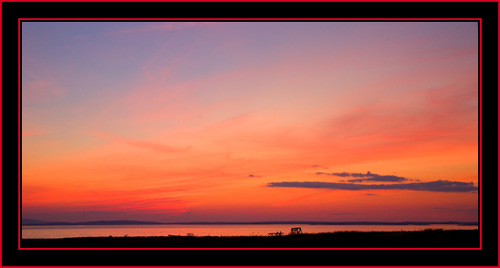
|
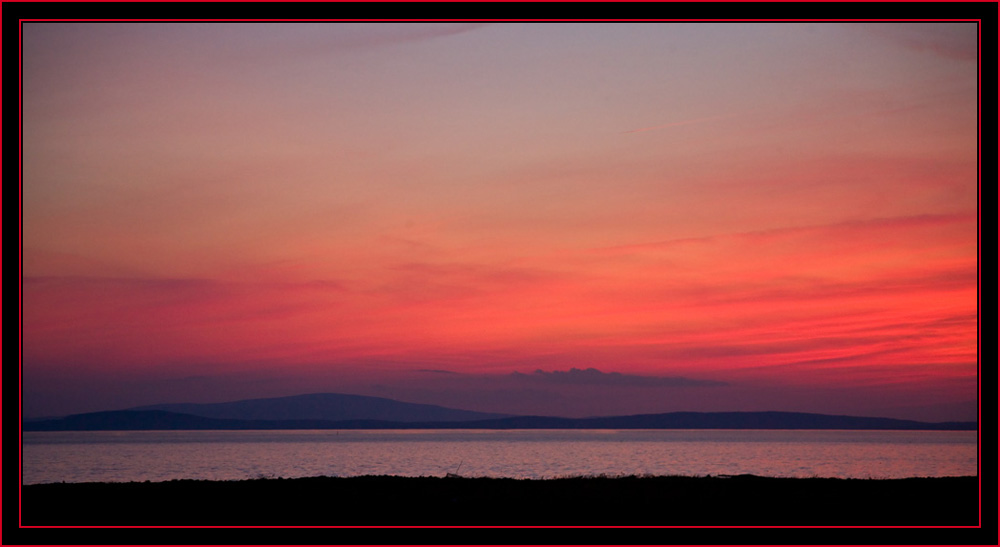
|
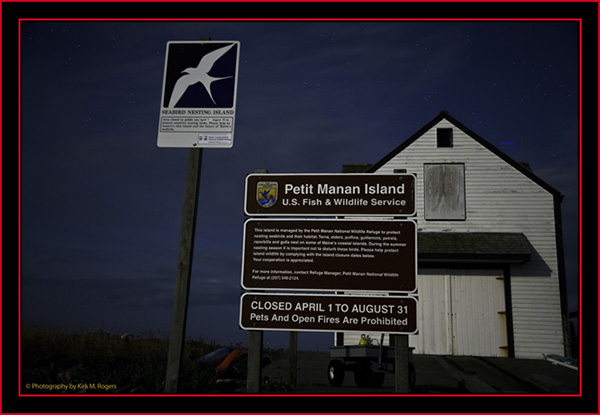
|
Soon it was dark which didn’t leave an overabundance of options as what to do next… It was a nice night and I checked out the moon to learn what possibilities may be presented. With minimal control on shutter speed without my timer release I knew it would be difficult to not overexpose the moon, but that didn’t mean using the light from it wasn’t an option. I’m glad I stayed out because overall I think the night shots turned out okay, plus appeared to be appreciated by the refuge staff after the fact.
Sign & Boathouse by MoonlightCanon EOS Mark III 1Ds on tripod, 25 seconds at 45mm; EF24~105mm f/4L at f/4, ISO 800 |
Night Views from Petit Manan
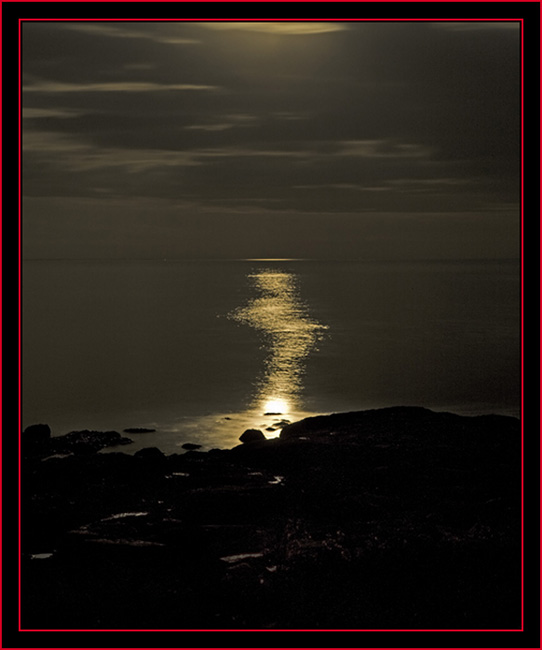
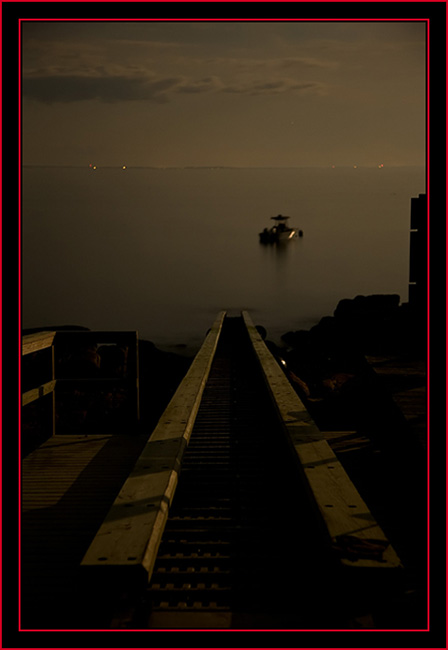
|
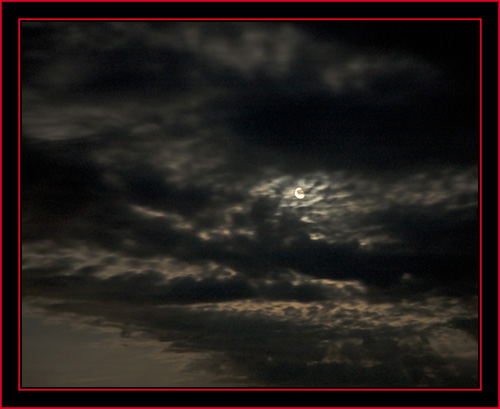
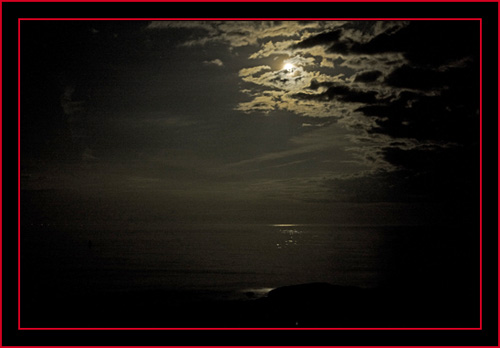
|
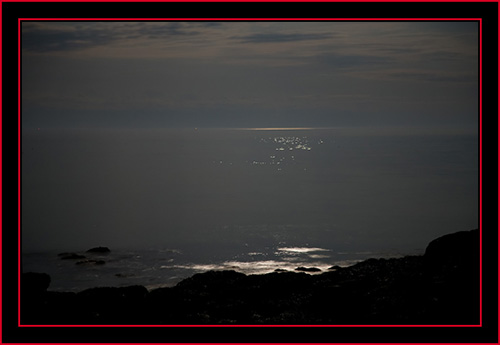
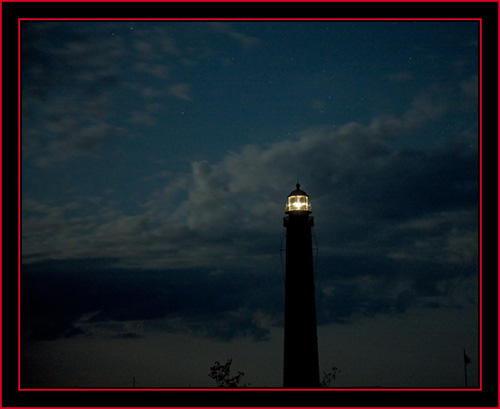
|
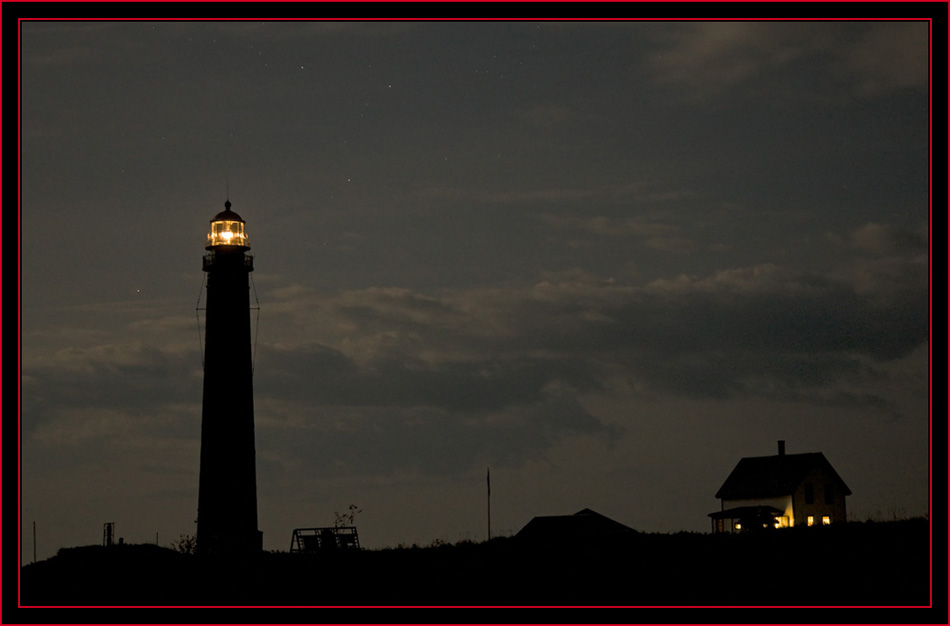
|
It had been an interesting day… I don’t know what time it was when I decided to crawl into my sleeping bag – I didn’t much care either in the overall course of things.
The only matter of import was daylight versus darkness here for the next few days. I recall thinking I should check the exact
time of sunrise then remembered I was just about devoid of electronics except for three cameras and my Blackberry – and yes, 'there’s an app for that', but not on my device... I used the astronomy flashlight I’d
packed to check the cameras for available space on the media cards and remaining battery power, prepared everything for in the morning and retired.
Least Sandpiper...Canon EOS Mark III 1Ds, 1/1000 second at 840mm; EF600mm f/4L + 1.4X at f/8, ISO 640 |
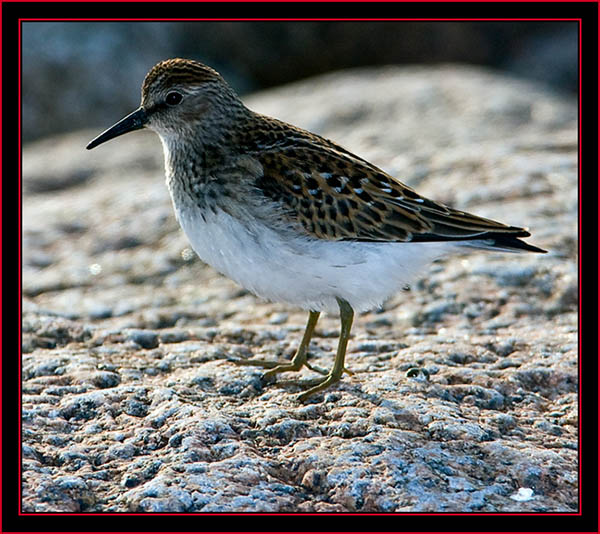
|

|
